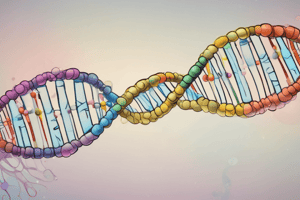Podcast
Questions and Answers
What is DNA replication?
What is DNA replication?
- The process of making identical copies of RNA before cell division
- The process of DNA transcription
- The process of making identical copies of DNA before cell division (correct)
- The process of making identical copies of proteins before cell division
What does the central dogma describe?
What does the central dogma describe?
DNA -> RNA -> Protein
What is the role of DNA helicase?
What is the role of DNA helicase?
To unwind the double helix of DNA and separate the DNA strands.
What is the function of DNA polymerase?
What is the function of DNA polymerase?
What is meant by double helix?
What is meant by double helix?
What are the stages of DNA replication?
What are the stages of DNA replication?
What is tRNA?
What is tRNA?
What is a codon?
What is a codon?
What is the function of the promoter in transcription?
What is the function of the promoter in transcription?
What does it mean if a mutation occurs during DNA replication?
What does it mean if a mutation occurs during DNA replication?
What is epigenetics?
What is epigenetics?
Flashcards are hidden until you start studying
Study Notes
DNA Structure and Replication
- DNA replication produces identical copies of DNA prior to cell division.
- Each DNA molecule comprises a double helix structure formed by two polynucleotide strands.
- Semi-conservative replication involves each original strand acting as a template for a new strand.
- Leading strands are synthesized continuously in the 5' to 3' direction, while lagging strands are synthesized discontinuously away from the replication fork.
- Key enzymes include DNA helicase (unwinds double helix), primase (synthesizes RNA primers), and DNA polymerase (adds nucleotides and proofreads).
- Replication forks are Y-shaped regions where DNA strands separate for replication to occur.
- Nucleotide composition includes a deoxyribose sugar, phosphate group, and nitrogenous bases (A, T, C, G).
- Mutations can occur during replication due to errors, with one erroneous nucleotide added per billion.
Transcription
- Transcription converts DNA into messenger RNA (mRNA) and occurs in three phases: initiation, elongation, and termination.
- RNA polymerase binds to the promoter region of a gene to start transcription, synthesizing mRNA based on the DNA template.
- The elongation phase involves the addition of RNA nucleotides to create a growing RNA chain.
- Transcription terminates when RNA polymerase reaches a specific terminator sequence.
Translation
- Translation is the process of synthesizing proteins from mRNA at ribosomes.
- Ribosomes consist of rRNA and proteins, facilitating the decoding of mRNA into polypeptides.
- tRNA acts as an interpreter during translation, bringing specific amino acids and matching them to mRNA codons.
- Codons, sequences of three nucleotide bases, code for specific amino acids; start codon (AUG) initiates translation, while stop codons signal the end.
- The codon table illustrates the relationship between codons and the amino acids they specify.
- Anticodons are the corresponding sequences on tRNA, pairing with mRNA codons.
Genetic Regulation
- Epigenetics involves heritable changes in gene expression that do not alter DNA sequences but can modify chromatin structures and thus phenotype.
- The nucleus houses the cell's DNA and is critical for genetic operations, including replication and transcription.
Prokaryotic vs Eukaryotic Replication
- Prokaryotes possess a single origin of replication, while eukaryotes have multiple origins, potentially numbering in the thousands, allowing for efficient and rapid DNA replication.
Studying That Suits You
Use AI to generate personalized quizzes and flashcards to suit your learning preferences.




